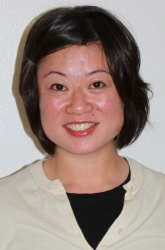
Lydia Tymon completed her Bachelor’s and Master’s degrees from the University of Washington in Botany and Forestry, respectively, and she completed her doctorate at Washington State University. Her dissertation was entitled “Frequency of isolation, determination, and epidemiology of
Alternaria species on potato in the Pacific Northwest.” Dr. Tymon is currently a postdoctoral research associate for Dr. Brenda Schroeder at the University of Idaho, where she is working with
Clavibacter michiganensis subsp.
sepedonicus, the bacterial ring rot pathogen, and with fungal and bacterial pathogens of onion.
Lydia Tymon completed her Bachelor’s and Master’s degrees from the University of Washington in Botany and Forestry, respectively, and she completed her doctorate at Washington State University. Her dissertation was entitled “Frequency of isolation, determination, and epidemiology of
Alternaria species on potato in the Pacific Northwest.” Dr. Tymon is currently a postdoctoral research associate for Dr. Brenda Schroeder at the University of Idaho, where she is working with
Clavibacter michiganensis subsp.
sepedonicus, the bacterial ring rot pathogen, and with fungal and bacterial pathogens of onion.
